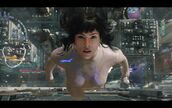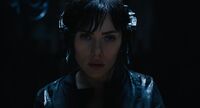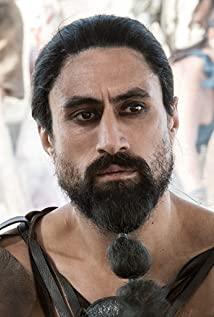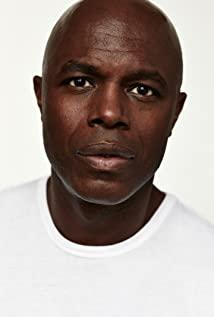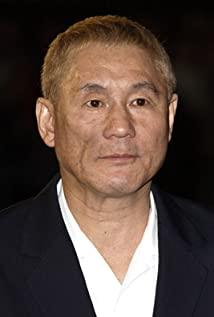"What I can't bear is that I can't accept that Motoko Kusanagi has some qualities that are beyond "major" and beyond an information warfare expert. When a character who always pursues the meaning of his own existence, he already has a hidden and extremely important identity At the same time, the pursuit of the meaning of its existence seems to have been limited to a category of hidden identity and social relations, and even when it is forced to involve the soul or something, it will be more of a rhetorical expression in the work. "
Really, basically accurate, that's pretty much my biggest opinion on this one. When this film has tampered with some basic settings, the most fascinating of the "Battling in the Shell" series, those things worthy of deep thinking have been dispelled at a deep level. Of course, it is very "smart" that, in order to avoid "exaggeration", the work directly escapes the most worthy of exploration of the hard core of "Battling in the Shell", but chooses something called "memory".
In fact, if the "memory" is explored in depth, it can always reach a deep enough level, not to mention, because of the background of science fiction, it may give this thinking some more flexible divergence and in-depth potential. But unfortunately, this movie does not seem to have the desire to think, but chooses a routine.
In the 1980s and 1990s, Paul Verhoeven used the "amnesia" routine of the sci-fi films "Total Recall" (translated into "Cosmic Power Dragon") and "Robocop".
Really, after so many years, this routine may be about to be played.
In fact, the two films in 2012 and 2014 were remade again, but they didn't plan to play this way again.
Relatively speaking, when the character is seeking self-identity within a social ethical structure, seeking about family, about friendship, about emotions, about work and career, etc., then this routine is actually reasonable and can be used - but if the role If what you want to explore is more in-depth, then this routine will be just a fake and inferior thing used by the creator when he does not understand it at all, let alone achieve the complete aesthetic perception it requires. .
From a certain point of view, such a random use of copying seems to be a fairly obvious tendency in this work.
The big business conspiracy theory is also taken from "Robocop", and the motorcycle that Suzi rides seems to be from "Special Police Judge". The villain who has a revenge obsession but has been whitewashed can be seen everywhere in the American comics. The Basset dog is the old man. Strange dog, the old man Araki who doesn't use his brain to do the killer business is Mr. Kitano Takeshi's own thing. In fact, if it weren't for the fact that this film had more or less the name of a live-action version, I would have considered jumping off the building, optical camouflage, puppet rumors, etc., as copying things in the category.
This copying is actually a stacking of symbols - the appearance of many science fiction elements is naturally to win over fans of science fiction, while the copying of elements of attack in the shell has the consideration of paying tribute and pleasing fans of attack in the shell. But the problem is the same as above. The director only used these things, and only considered whether these things were science fiction or part of "beating the shell", but never considered the concept of the appearance of these symbols in the original work. What effect was achieved.
Therefore, many symbols that should be used to construct an aesthetic perception system are only presented in fragments. For science fiction works, there are so many symbols, and there is a need for world construction: but in this work, will we have an illusion that the world composed of images can be reached at one touch? Is there a kind of illusion that the world is described so real and appropriate, as if it really exists in parallel time and space, and we can project it into it?
I really don't have it anyway.
Even if this film constantly has bird's-eye panoramic aerial shots of the future city, and will constantly use some high-tech things to create some "shock" effects - but these are still only scattered things.
This should be regarded as the pot of symbol transfer, but in fact, I also think that this is the result of this work entering another bad routine.
As mentioned above, I have chosen to use the stacking of symbols to please science fiction fans and shell fans - so how to attract a wider audience other than these people?
Just use Hollywood's most basic, or even the most conservative, audio-visual language and means of expression.
This ensures that the meaning is crisp and easy to understand, and with a bit of good enough special effects, a relatively decent script would be nice.
Yesterday I also thought about it, so I thought that I should be able to pass the filming of "Blade Runner".
But it was only today that I found out that even though the work has made a conservative choice to strike a balance between fan dramas and movies, it does not even dare to choose something more than 30 years ago in terms of the degree of conservativeness in its means of expression. .
Starting from the lens language, it just changes with the flow of the character's vision and hearing, and the interaction scene will always have only a few simple front and back shots. The action scenes are always carried out in a studio that cannot be unfolded at all, and they take the trouble to repeatedly use a few medium shots and slow downs. These things are quite satisfactory, but the action is not clear, and the visual impact is not enough. , and even I can't understand what it is necessary to use. That is to say, for example, the few "deep dive" passages can't explain what they did, and from the nightclub steel pipe to the multi-player electric shock Play, they also lack the violent beauty of fighting.
The film restores some classic scenes from the "Beat in the Shell" series: jumping off the building, mechanical geisha rescue, waterway fights, dismantling tanks with bare hands, etc. - I really don't know why it can be done just by taking pictures. It's the culmination of those stale and boring lens language. Even so, these are some of the best moments in the entire film.
Regarding the story, this work seems to try to fit it into a character growth process about seeking, so as to achieve the audience's moral value intake. But the narrative has no courage at all to violate the time law of "growth", and uses techniques such as flashbacks, and even at the beginning, dare not let Mozi jump off the building before creating her prosthetic body. In the dull narrative, some paragraphs that apply the retrospective method to expand the thinking cannot be achieved, and some inner excavations cannot be achieved on the basis of poor storytelling.
The representation of the camera is insufficient, the representation of the narrative is not enough, and even a large number of words are used, that is, let the characters speak some connotative things directly in words - it seems that the original comics, an adapted image, and In the end it turned into a work of literature. Just for the convenience and clarity of the meaning of the text, "Jack in the Shell" makes the ambiguous side of the meaning in the image to be thrown somewhere.
And this "text communication" is different from Bart's rambled words in "Innocent". The mouth is full of words, and there is also a lack of image assistance to achieve a vertical montage. It just constitutes some middle-two in the front and back, which is dull. The blank dialogue, which is completely no longer able to form a complete and unified structure with the image.
The rhythm of this film also seems to have committed "symbol abuse" films, such as "The Bourne Bourne 5", their usual mistakes: a strong sense of rupture and paragraph sense. These make the passages operate in a completely unrelated form, which further deepens the fragmentation of the works caused by the symbols, and the story seems to be difficult to proceed to a clear level in the divided passages, and even the emotions of the characters are also Can't get the liberation it deserves in every passage - but of course, the character emotions themselves are all dissociated.
Just as the "future city" and "high-tech" elements mentioned above fail to form a world - in the sense of "freedom", this is because they are not related to the characters and the story, but also It can be considered that this is because the characters' own behavior, language, etc. are also outside the world: they never seem to need to interact with the situation, they only need to say a few words inexplicably, inexplicably let emotions Being vented, two people were beaten inexplicably.
Even the performance is inexplicable. Due to the change in settings, Motoko Kusanagi is no longer a seasoned major, no longer an expert in urban operations and information warfare, and no longer a "woman" with a strong sense of ethics. At this time, not long after she joined the Nine Lessons, she had some secrets to seek. She did not possess the calmness, will, and ability that a combat expert should have. All she could rely on was her prosthetic body.
——So, she turned into a somewhat angry middle-aged and second-stage perverted young woman.
But what amazes me the most is that this is actually performed vividly by the widow sister.
Wow, to be honest, I've never seen a normal girl hunched over, stretched her neck, stretched her arms and legs straight forward.
Especially at this time, the face still has the texture that someone else owes her two hundred dollars.
Or it's the confused texture of what you just ate after eating shit.
Seriously, why would anyone not want to laugh when they see this?
No matter how confused Suzi is in the 95 version of "The Shell", her body is relaxed. No matter how I think about it, I feel that Scarlett Johansson who can play Lucy and a widow should be fine.
It's really too exaggerated and too deliberately performed. It's really inexplicable. It's really better to relax.
Even if I say it's really okay to just make the character a bitch in the manga.
Why let the whole work continue to be inexplicably empty?
So in summary, I always think, I recommend entering the theater about ten minutes before the end of the movie.
Because it seems that the best place in this film should be the "Puppet Ballad" at the end.
This version is well edited, it sounds really good.
-------------------------------------------------- -------------------------------------------------- -------------
Finally, I thought about the role of Kuze Hero, although it seems to be integrated with the puppet master 2501...
But really, the revolutionary turned into a boy with a puzzle face in the second radio wave... a bit angry …
View more about Ghost in the Shell reviews





